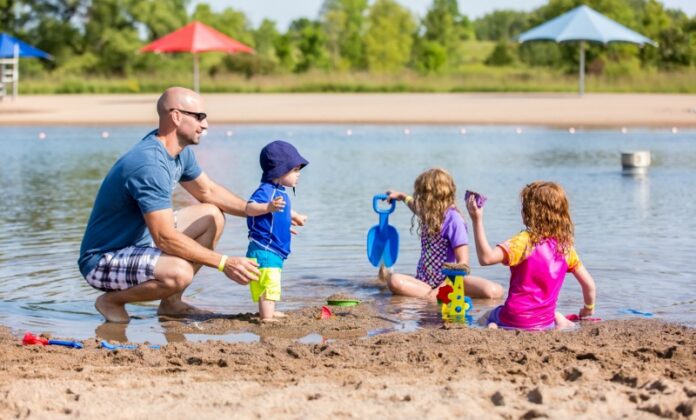During the summer months, many parents search online for tips to prevent drowning in backyard pools. But lakes, rivers and open water present additional risks that pools don’t have. Safe Kids Worldwide offers tips to prepare your family for them before packing for vacation.
Be Aware
According to Jill Lucas-Drakeford, a Carilion Clinic community health educator and the coordinator for Safe Kids Southwest Virginia, more children and teens drown in open water than in pools. Watch out for the following hazards when preparing to swim in the lakes, rivers or oceans:
Underwater obstacles: Murky lake and river water can hide sharp or slippery rocks, uneven or unstable logs, and “strainers” or underwater branches and root systems that can easily catch your feet. These are constantly changing in unpredictable ways.
Depth and distance changes: Gently sloped shorelines can hide sudden drop-offs farther out, especially at the ocean or in moving rivers, where tides and changing conditions can move the sand and soil underfoot from one day to the next.
Currents and tides: Rip tides and underwater currents can be strong, fast-moving and unpredictable, especially for families who only visit lakes and oceans occasionally. Avoid swimming at unsupervised beaches or in areas not designated for swimming, and be sure kids know how to deal with a crashing wave before swimming in open water.
Water temperature: Open water tends to be colder than the pools where kids often learn to swim. That can affect a child’s swimming ability and even cause panic if they fall in or get in too quickly.
Weather changes: While a summer thunderstorm makes swimming pools dangerous until it passes, the effects of weather on open water are longer lasting. Heavy rains and flooding can quickly change currents, temperatures and depth.
Water-borne bacteria: Summer storms can release fertilizers, insecticides and even sewage into lakes and rivers. Open wounds can become infected by bacteria that live in both fresh and saltwater environments.
Be Prepared
Just as you would at the pool, keep a watchful eye on your children at all times.
“The most important safety consideration is to make sure you ALWAYS watch your kids in and around water without being distracted, and be within an arm’s reach,” says Lucas-Drakeford.
The following steps can also help ensure that your family remains safe in and around the water.
- Be sure everyone in your family knows how to swim
- Take a CPR class through your local American Red Cross chapter and keep it current each year.
- Swim only in designated swimming areas and take heed of any posted warnings
- Avoid stagnant water, and water that has oil or algae on its surface
- Don’t swim if you have open wounds or un-healed cuts
- Wear water shoes to prevent cuts from sharp shells and stones
- Wear nose clips if swimming in warm lakes, especially if the soil is agitated or churning
- Dress for the water temperature, not than the air temperature
- Always wear a U.S. Coast Guard-approved life vest; the SafeKids video below shows the proper way to fit one on your child
By considering the risks ahead of time and being prepared with alternative activities such as board games and frisbees, your family will have a safe, enjoyable vacation no matter the weather.



